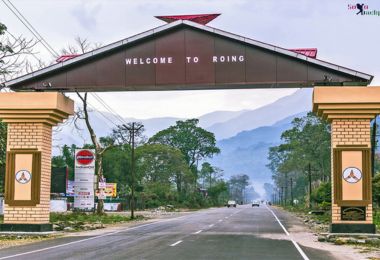arunachal pradesh: A Glimpse
Arunachal Pradesh means the state of dawn-lit mountains. Arunachal has a diverse culture, mountainous terrain and scenic beauty. Arunachal is a border state of India in the North East. It shares international borders with four countries — Bhutan in the west, Myanmar in the east and Tibet and China in the north. Only Assam and Nagaland are its entry points to the rest of India. Because of such a strategic location, the state has always been in the political and public gaze of the country. With an area of 83,743 sq. km, Arunachal Pradesh is the largest among the north-eastern states of India
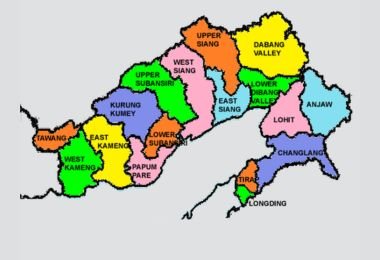
state symbols of arunachal
The state animal, the Mithun (bos frontalis), is a robust and revered creature, symbolizing strength and cultural significance in the region. The Great Hornbill is chosen as the state bird of Arunachal Pradesh. The hollong, designated as the state tree, stands as a testament to the state’s commitment to environmental conservation. Complementing this ecological tapestry is the state flower, the Lady’s Slipper Orchid, which adds a touch of elegance to Arunachal Pradesh’s diverse floral spectrum.
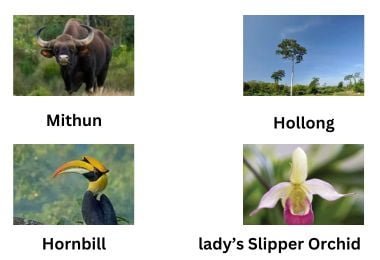
Formation of as a state of NE India
Arunachal Pradesh is a relatively recent addition to the list of Indian states. It transitioned from being a Union Territory (UT) for 15 years, from 1972 to 20 February 1987, when it attained statehood. The name Arunachal Pradesh was officially conferred during this transition. Before its UT status, the region was referred to as the North East Frontier Agency (NEFA) and was under the direct administration of the Ministry of External Affairs, Government of India.
Demography
Arunachal is sparsely populated, the total population being 13.83 lakh as per the Census 2011. Arunachal is home to some 30 communities and their 47 sub-groups. The list of Scheduled Tribes includes 25 tribes. Of the remaining five communities, Meyor, Mikir, Mishing and Lisu, have been given the facilities due to the Scheduled Tribes, but are not recognised as such by the state government. The fifth, i.e., Chakmas, is regarded as a non-tribal community.
Cultural Zones of arunachal pradesh
Going by the settlements, the state is divided into five cultural zones. The first is the Tawang and Kameng regions, where the tribes settled are Buddhist Monpas, Sherdupens, Akas, Mijis and Khowas. The second zone lying to the east of the first covers the area of East Kameng and Lower and Upper Subansiri. The tribes settled there are Nyishis, Banginis, Sulungs, Apatanis, Nas, Tagins Mikirs and Hill Miris. The third zone covers some parts of the Upper Subansiri and the East and West Siang districts, where the Adis, a major tribe, dominate. The Adis have 15 sub-tribes, namely the Ashing, Bori, Karko, Milang, Padam, Pangi, Ramo, Tangam, Bokar, Gallong, Komkar, Minyong, Pailibo, Pasi and Shimon. The Dibang Valley and Lohit regions constitute the fourth cultural zone, where the major tribes include Khamtis and Mishmis. The fifth zone spreads over the Tirap and Changlang regions and includes tribes like Noctes, Wanchos, Tangsas and Singphos
Religious beliefs of people
By and large, the Arunachalis are animists, worshipping the nature god. They believe in a supreme god, who is not only omnipresent and omniscient but also just and benevolent. For example, the Adi group of people worship ‘Donyi-Polo’ (the sun-moon god), who they believe observes every minor development and upholds the truth in the world. Oath taken in his name becomes most binding of all. On every ritual, his name is invoked. Donyi-Polo as a religious faith has become a unifying force for people in large parts of Arunachal. In the regions bordering Bhutan, Tibet and Myanmar, the Monpas, Sherdukpens and the Khamtis follow Buddhism. As happens in every religion, the practice of Buddhism in Arunachal has been greatly impacted by the local tradition of nature worship and food habits, etc. Christianity and Hinduism in a major way and Islam, Jainism and Sikhism in smaller ways have also established their presence in the state in the last few decades. This is so, because there is a large community of migrants from the rest of India in the field of trade, construction and in various administrative offices. All these people have also brought in their religious faiths and cultures to the state.
village administration
Village is the centre of community life in Arunachal Pradesh. Every village has a council to maintain the social order. The customary laws guide the functioning of the village council. The Adis term the village council as kebang and the inter-village council as bango. The latter is meant for the settlement of bigger disputes involving more than one village. There is a village headman, but the decisions are believed to be coming from the raij (people) as a whole, with strict impartiality towards both the contending parties. The headman is called gaon burha, because of his rich life experiences and respectability for giving elderly counselling. His position is hereditary but if needed, he could be replaced, the decision for which could be taken by other village elders. The women generally do not take active part in the council matters. The disputes are mainly related to non-payment of bride-price, marriage, theft, etc. Capital punishment is generally avoided and penalty either in cash or kind is preferred. The political and judicial system in traditional Arunachal is generally democratic, simple and effective. However, in contemporary times, the basic structure of customary governance is being overtaken by formal administrative and judicial system.
Brief history of Arunachal
The ancient and medieval history of Arunachal remains shrouded in the midst of legends and mythology. Written references to local people in Arunachal first appeared in Ahom Burunjis (chronicles) and later in the Mughal Chronicles during the medieval period.
Arunachal is full of hills and forests. Its plain area, which is scanty, was probably under the minimal possession of the Sutiyas and Kalitas of Assam in ancient times. Subsequently, the Ahoms brought the entire plain stretch under their control. This brought them in direct contact with the local tribal communities, and was followed by sporadic raids and plundering by tribals in the foothills and retaliatory measures by the Ahoms in the hills. Finally, the Ahoms decided to contain the tribals in their own hills and conceded to pay posa, a kind of tax, to some tribes for the purpose.
Arunachal during british rule
The British replaced the Ahoms in Assam in 1826. In the next 12 years (1838), the British fully consolidated their position over the entire region. In 1873, they introduced the Inner Line, a regulation meant to segregate the populace of the hills from those of the plains. The hills in the North East were made a Non-Regulation Province of British India. Going beyond this Line required a licence. The Regulation also earmarked rules regarding trade and possession of land, etc., within the Inner Line. Thus, the British brought the hills under their administrative control without much interference in the lives of the people there. In 1914, the hill area in the north of Assam, which later became Arunachal, was separated from the plains to form the North East Frontier Tract. After the Independence of the nation, the region was named North East Frontier Agency or NEFA in short in 1954.
resistance to british rule
The tribal people of Arunachal fiercely resisted the British on the latter’s unwelcome moves. The tribals, though unaware of the British rule and its exploitative nature, considered the British as hostile to their society. This led to frequent clashes between the British and the tribal communities. In March 1911, one such British attempt was averted at Yagrung village near Pasighat in East Siang. A British officer named Noel Williamson and his Indian subordinate officials were killed by the villagers led by their village head, Jamoh. Following this, there was an unleash of British terror in the region. Known as the Abor Expedition (1911) in modern history, it led to large-scale torture and suppression of the local tribal people. Before this, the Apatani people from Ziro Valley had also resisted the British and had faced hard suppression in 1896. Despite such suppression, the Arunachal people could not be silenced, thereby, compelling the British to keep away from their society to a large extent. Thus, the British design to subjugate the local communities was often thwarted in Arunachal Pradesh at an early stage.
Natural Vegetation and Biodiversity
Most of Arunachal is covered by the Himalayan range. In addition, the Patkai Hills also cover parts of Lohit, Changlang and Tirap regions, bordering Myanmar in the east. The state has a narrow belt of foothill plains along the border with Assam. There are also some beautiful valleys such as Apatani in the Lower Subansiri district. Arunachal is covered by a dense evergreen forest. Forest products such as bamboo, cane, timber and medicinal plants are abundant in the state.
Arunachal is a home to species of nearly 5,000 plants, more than 600 birds and close to 100 terrestrial mammals. The hornbill is a unique bird found mostly in the forests here. The mithun (bos frontalis), a semi-domesticated animal, is unique to the state. It plays an important role in the socio-cultural life of the people. In the past, when money economy was almost absent, mithun also served as the medium of exchange in the Arunachal tribal society. The yak in the higher region plays almost a similar role as that of the mithun. Besides elephant, bear, barking deer, porcupine, etc., there are innumerable species of butterflies, insects and reptiles. The mountain slopes and hills are covered with alpine, oak, maple, fir, sal and teak trees, etc. A large variety of orchids grow in the state, enriching its endowment of flora. Such biodiversities make Arunachal a paradise for both botanists and zoologists.
Climate of Arunachal
There are only two seasons in Arunachal Pradesh — winter and rainy. The average annual rainfall ranges from 300 to 400 cm. The rainy season generally lasts from April to October. The transport and communication systems often get disrupted during the period. The temperature in the plains and foothills could even go as high as 40 degrees Celsius, whereas it can be as low as zero degree Celsius in higher altitudes.
Festivals and Dances
Festivals are plentiful in Arunachal. Each tribe has its own festival, which provides a creative forum for expressing the distinctness of their art forms, dresses, designs, dance forms, musical instruments, etc. The festivals are generally related to agricultural activities like sowing and harvesting. There are collective rituals performed and celebrated in public by the community as a whole. Both women and men dance during the festivals. The songs of the festivals show that they are celebrated for the harmony and prosperity of the people and fertility of the land. The women actively and publicly participate during the time of festivals, work in the fields and engage in the trade of buying and selling goods in the market without any discrimination or insecurity. In recent times, the presence and participation of women in offices is also quite pre-ponderous. Some of the local festivals are—‘Solung’ celebrated by the Adis in Siang and Dibang valley, ‘Nyokom’ celebrated by Nyishis, ‘Mopin’ by Gallongs, ‘Lossar’ by Monpas, ‘Dree’ by Apatanis, ‘Loku’ by Noctes and ‘Boori-Boot’ celebrated by the Hill Miris, etc. Like the dance which takes place in all festivals, prayers and sacrifices are also common. The indigenous dress, which is a product of local people’s long interaction with their ecological settings, makes the festivals exceedingly lively and colourful. In Arunachal, Durga Puja, Vishwakarma Puja, Christmas, Baisakhi and Eid are also celebrated with equal zest and fervour, especially in urban centres like Pasighat, Ziro, Itanagar, Along, Tezu and Bomdila, where there is a visible presence of non-Arunachali population. A common feature of all festivals, including tribal festivals is that while the festivals may be organised by the followers of a concerned faith, people from all walks of life participate in them enthusiastically. This is a product of the co-habitation of innumerable tribes and sub-tribes in the region coupled with their distinct religious faiths, and above all their growing interaction with others in modern times.
Tourist Places of Arunachal
Tawang
Tawang in the west is a beautiful hill town. Located at 10,000 ft. above sea level, it has the largest and one of the oldest (400 years old) Buddhist monasteries in India. The colourful gompas and Buddhist prayer flags dot the landscape and invite visitors to experience a unique culture while being welcomed by the warm people of the town. Tawang is located at a distance of approximately 555 km from Guwahati and 320 km from Tezpur.
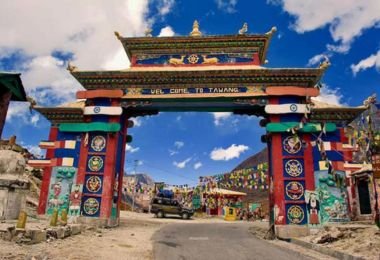
Itanagar
Itanagar taking its name from the medieval fort city of Ita Hills has developed as the largest town in the state with the State Secretariat, Governor House, museum, a lake, a zoological park, etc. The museum has a large collection of the tribal heritage of Arunachal Pradesh. The nearby Gompa, a yellow-roofed Buddhist temple, was consecrated by the Dalai Lama. West of town is Geker Sinying, also known as Ganga Lake, surrounded by forests, orchids and ferns
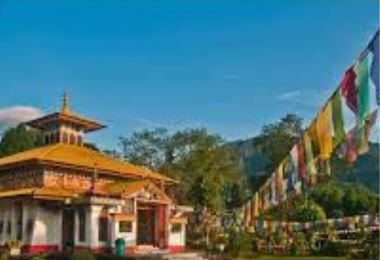
Roing
Roing in the Lower Dibang valley is full of beautiful lakes and waterfalls. It is the district headquarter of Lower Dibang valley and is mythologically identified with the birthplace of Rukmini, the wife of Lord Krishna. Notable tourist attractions are Mehao wild life sanctuary, Sally lake, Mehao lake, Bhismaknagar Fort and Mayodia pass which remains covered with snow during peak winter.
